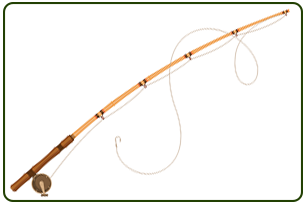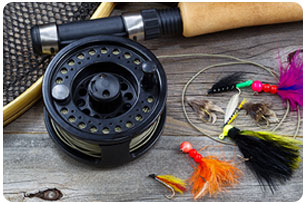
As with baitcasting and spinning rods, fly rods are available in various lengths, weights and actions.
Fly Rods

Fly rods are typically constructed of fiberglass, graphite or bamboo and are designed to accept a fly reel on the bottom side of the rod in order to align with its line guides.
Fly rods are also produced in single or multi-piece versions as to meet the needs and desires of different anglers, and come in a wide range of weights (or powers) which are generally described on a numeric scale – e.g. 2-weight, 4-weight, 6-weight etc.
- When to use: Similar to spinning rods, fly rods are extremely versatile and are used by anglers pursuing diverse species of fish from small to large. Though most popular among river and stream anglers, fly rods are also used in open-water applications on ponds, lakes and reservoirs. Some of the most common artificial lures used on fly rods include dry flies, wet flies, streamers, poppers and egg flies, among others.
Key Terms
Rod Weight / Power: The “power” or “weight” of a fishing rod refers to how much force or weight it takes to bend the rod. Different rod powers or weights are designed handle specific ranges of lure weights and line sizes.
To determine which rod power or weight will be best for you, consider what lure weights and line sizes you will be using with the rod most often, as well as the general size of the fish species you’ll be targeting.
Rod Action: The “action” of a fishing rod is determined by where the flex occurs along the rod. For example, faster action rods tend to flex more near the tip while moderate or slower action rods tend to flex more into the middle and lower sections of the fishing rod.
Fly Reels

Typically made of aluminum, stainless steel or composite materials, fly reels are designed to be mounted on the bottom side of a fly rod and accommodate varying amounts of fly line. Fly reels, which are often made to be converted from right-to-left hand retrieves, are also available in manual and automatic styles.
Manual reels, which are most common, require the spool to be turned by the reel handle in order to take up line. In contrast, automatic reels feature a coil and lever design that allows line to automatically be taken up by squeezing the lever.
As with any type of fishing reel, a fly reel should be selected based on an angler’s proficiency, the type of fishing they will be doing and the fly rod they will be pairing the reel with.
Key Terms
Gear Ratio: Reel gear ratios – such as 6.3:1 or 5.2:1 – describe the number of rotations a reel spool will make with one complete turn of the fishing reel handle. For example, a 6.3:1 ratio means that the reel’s spool will rotate 6.3 times with each turn of the reel handle. Some fishing applications may require a high-speed reel that picks up more fishing line with each turn of the handle, while other applications may be better accommodated by a slower-speed reel that allows for a slow, methodical retrieve, or greater cranking power.
Drag: Fishing reel drag systems are braking mechanisms designed to apply resistance to the reel’s line spool or drive components. These adjustable, mechanical systems help anglers to keep adequate pressure on a fish after it is hooked, without breaking the fishing line. Quality drag systems on various types of reels will allow the fishing line to slowly discharge from the reel at a smooth, steady rate. Combined with fishing rod length, action, and power, properly adjusted reel drag systems enable anglers to successfully tackle and land fish species of varying types and sizes.
Line Capacity: A fishing reel’s line capacity simply refers to the amount of fishing line, of a given size or diameter, that a reel can adequately hold. Fishing reels generally come with a chart or table that explains the expected capacity of fishing lines of different “pound tests”, or sizes. Therefore, line capacity is a key factor for anglers when considering which reel they should purchase or use dependent on the type of fishing they will be doing and the species of fish they will be pursuing.
